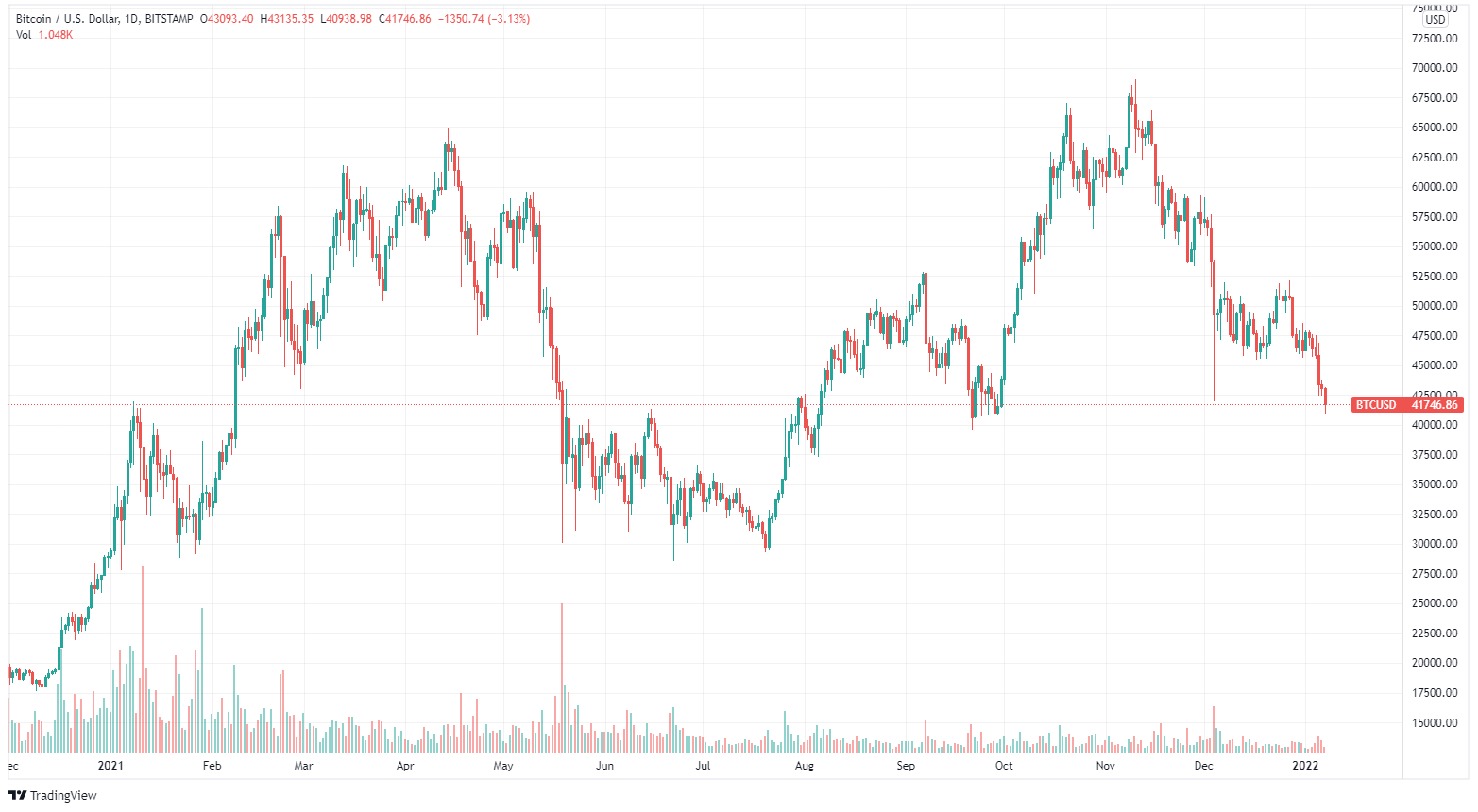Good Morning!
During the first few days of the new year, the overall market traded in a very narrow range. Then we have continued hawkish US Federal Reserve signals and rising US 10-year yields. The primary focus here is on the number of rate increases, and just how aggressive the Fed will be with its balance sheet runoff. Equities and base metals slid followed by cryptocurrencies.
Choppy market-behaviour
Prior to the market correction, Bitcoin seemed to have lost some of its dominance against other cryptocurrencies, but when we are in "risk-off" mode, there is no escape. Bitcoin (BTC) and Ethereum (ETH) lost over 10%, and short-term volatility obviously spiked.

This choppy market behaviour favours the market makers (liquidity providers) in the newly launched DeFi options vaults. The short-term simple options strategies leave the market maker with long out-of-the-money calls and put positions in the corresponding cryptocurrencies. These long option positions are ideal for intraday trading as the market maker ends up being long gamma and therefore flexible to catch up with the high time decay of the overall position.
Our desk is following this closely, and we are also asking ourselves to what degree these kinds of positions have been hedged in the market. At any rate, 2022 is now here, and we expect it to be a year chock-full of interesting and mind-blowing events.
The world of DeFi
One of these comes from the world of decentralized Finance (DeFi), with the move from DeFi 1.0 to DeFi 2.0. DeFi is still in its nascent stage, but it is evolving extremely quickly. Recent developments aimed to address some of the shortcomings of liquidity dependent pools. One should not forget that Decentralised Exchanges (DEXs) rely greatly on Automated Market Making and on Liquidity Providers to maintain their kind of permissionless nature, as do Lending and Borrowing protocols in order to build a sustainable L&B market platform.
In other words, one of the primary problems of DeFi 1.0 is that many protocols do not have deep liquidity! The explosive growth of DeFi, in general, has motivated other protocols to mitigate these problems by introducing the idea of Protocol Controlled Liquidity. These protocols do not rely on Liquidity Pools to bootstrap and maintain liquidity; instead, they actually rely on their own liquidity. One example of a DeFi 2.0 protocol is Olympus DAO.
What is Olympus DAO?
Olympus is a “non-pegged stablecoin” that attempts to be less volatile than traditional cryptocurrencies, while not being pegged to any Fiat currency. Olympus is positioned as a reserve currency protocol, whereas the native token, OHM, is backed by a basket of assets that are stored in the treasury. The value of OHM is meant to float based on the value of its underlying assets within the treasury. This is eventually achieved through minting and burning OHM according to the intrinsic value.
Users can participate and earn OHM through the purchase of OHM denominated bonds and by staking their own OHMs. Treasury revenues are increased by bond sales and fees, which lock in liquidity and help to control the overall OHM supply. The inflow out of the treasury is used to increase the overall treasury balance, back outstanding OHM positions, and regulate the staking APY (annual percentage yield). In a nutshell, the target of the protocol is to become a crypto native currency that is used as an alternative to other Fiat currencies.
All intellectual property, proprietary and other rights and interests in this publication and the subject matter hereof are owned by Crypto Broker AG including, without limitation, all registered design, copyright, trademark and service mark rights.
Disclaimer
This publication provided by Crypto Broker AG, a corporate entity registered under Swiss law, is published for information purposes only. This publication shall not constitute any investment advice respectively does not constitute an offer, solicitation or recommendation to acquire or dispose of any investment or to engage in any other transaction. This publication is not intended for solicitation purposes but only for use as general information. All descriptions, examples and calculations contained in this publication are for illustrative purposes only. While reasonable care has been taken in the preparation of this publication to provide details that are accurate and not misleading at the time of publication, Crypto Broker AG (a) does not make any representations or warranties regarding the information contained herein, whether express or implied, including without limitation any implied warranty of merchantability or fitness for a particular purpose or any warranty with respect to the accuracy, correctness, quality, completeness or timeliness of such information, and (b) shall not be responsible or liable for any third party’s use of any information contained herein under any circumstances, including, without limitation, in connection with actual trading or otherwise or for any errors or omissions contained in this publication.
Risk disclosure
Investments in virtual currencies are high-risk investments with the risk of total loss of the investment and you should not invest in virtual currencies unless you understand and can bear the risks involved with such investments. No information provided in this publication shall constitute investment advice. Crypto Broker AG excludes its liability for any losses arising from the use of, or reliance on, information provided in this publication.







